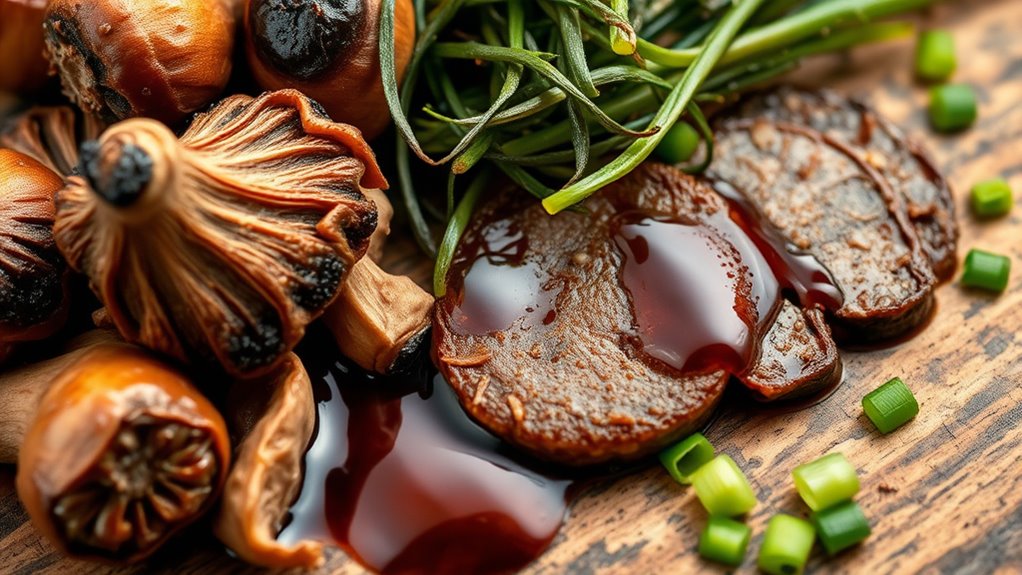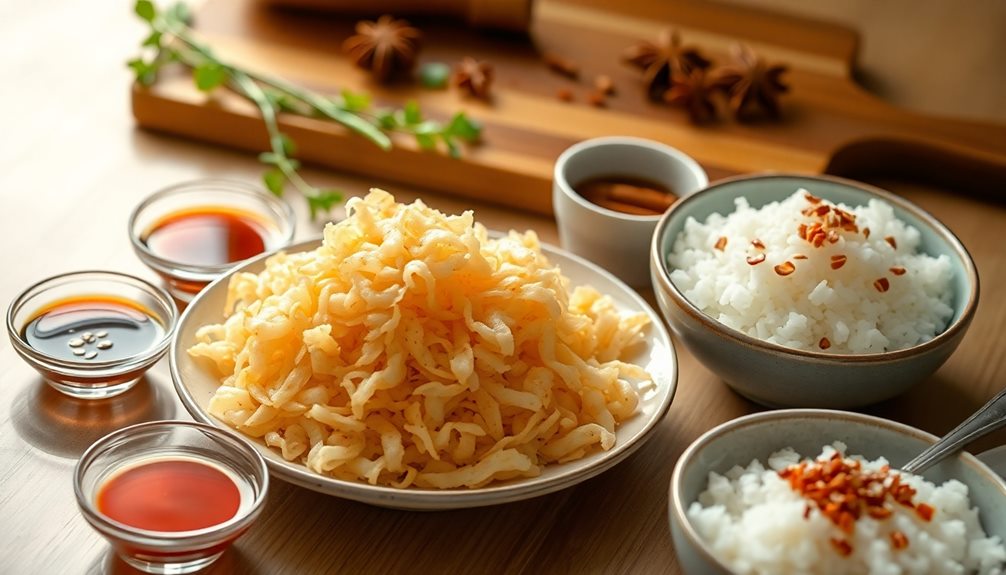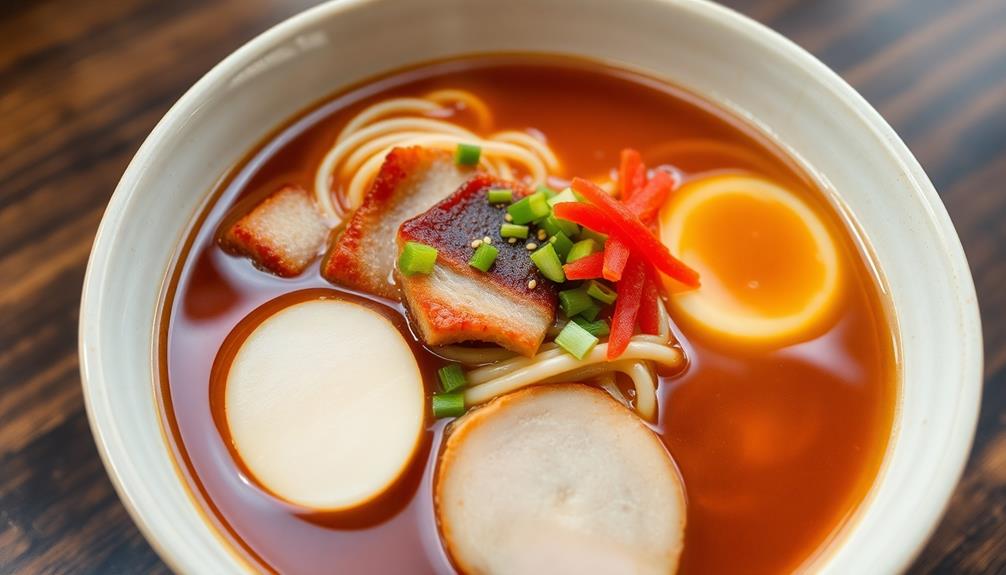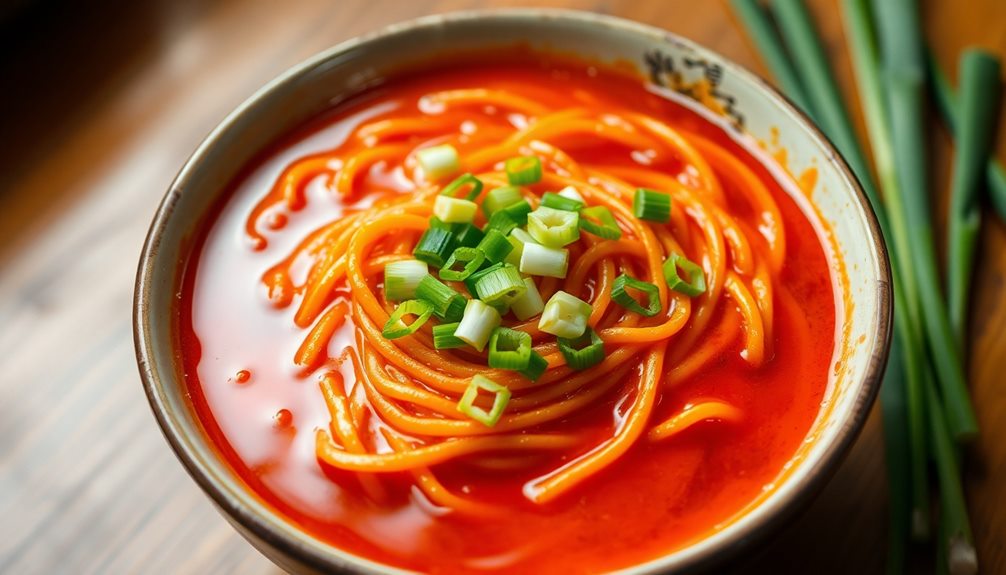To understand umami, explore Asian ingredients like soy sauce, miso, and fish sauce, which are naturally rich in glutamate from fermentation. These ingredients boost flavor by enhancing savory richness and depth, making dishes more satisfying without adding extra salt or sugar. They transform simple ingredients into complex, flavorful meals, highlighting the importance of fermentation in developing umami. Keep exploring to discover how these traditional elements can elevate your cooking even further.
Key Takeaways
- Umami is a savory, satisfying flavor that enhances dishes by deepening taste without overpowering.
- Fermented ingredients like soy sauce, miso, and fish sauce release glutamate, the key compound for umami.
- Asian fermented foods add complexity, richness, and nutritional benefits to various dishes.
- Incorporating umami-rich ingredients amplifies flavors, reduces the need for salt or sugar, and creates more satisfying meals.
- Using traditional fermentation techniques unlocks natural, balanced umami, elevating overall cooking quality.

Have you ever wondered why certain foods taste so deeply satisfying even without added salt or sugar? It’s often because of umami, a savory flavor that enhances dishes in ways that go beyond basic tastes. This rich, mouthwatering sensation is a key element in many Asian cuisines, and understanding it can transform your cooking. At the heart of umami are ingredients that serve as natural flavor enhancers, intensifying the taste without overwhelming the palate. These ingredients often owe their depth to fermentation techniques, which break down proteins and release amino acids like glutamate, creating that signature umami flavor. Think of soy sauce, miso, or fish sauce—these are prime examples of fermented products that pack a savory punch. By mastering the use of fermentation techniques, you can access layers of flavor that elevate simple ingredients into complex, satisfying dishes.
Asian ingredients that boost flavor through fermentation are particularly remarkable because they develop nuanced tastes over time. When you incorporate products like fermented bean pastes or aged soy, you’re adding not just saltiness but a deep, tangy richness that enhances everything from soups to marinades. These fermentation techniques transform humble ingredients into powerful flavor enhancers, revealing umami in its purest form. Unlike artificial flavor enhancers, which can sometimes leave a synthetic aftertaste, naturally fermented ingredients bring a balanced, rounded savor that complements other flavors without overpowering them. This natural approach allows you to create more wholesome, layered dishes that satisfy the palate and provide nutritional benefits as well.
Using umami-rich ingredients is also about understanding how they work together. When you add a splash of soy sauce or a spoonful of miso to your cooking, you’re not just seasoning; you’re amplifying the inherent flavors of the other ingredients. This synergy makes your dishes more complex and satisfying, even if you’re reducing salt or sugar. The key lies in recognizing fermentation’s role as a technique that release umami’s potential. It’s like tapping into a natural flavor amplifier that brings out the best in your ingredients. As you experiment with these flavors, you’ll discover how fermentation techniques turn simple foods into culinary masterpieces, making every bite more memorable and deeply satisfying.
In essence, understanding umami involves appreciating how fermentation techniques and traditional Asian ingredients serve as natural flavor enhancers. They allow you to craft dishes that are rich, savory, and deeply nourishing, without relying heavily on salt or sugar. By incorporating these ingredients thoughtfully, you harness the power of umami to elevate your cooking, creating flavors that linger and satisfy long after the meal is over.
Frequently Asked Questions
How Can I Identify Umami-Rich Ingredients in My Pantry?
To identify umami-rich ingredients in your pantry staples, look for flavor indicators like a savory, meaty, or broth-like aroma and taste. Common umami sources include soy sauce, miso, dried mushrooms, fish sauce, and fermented foods. These ingredients often have a deep, complex flavor that enhances dishes. Keep an eye out for packaging that highlights umami or savory qualities, helping you easily spot these flavor boosters.
Are There Health Benefits Associated With Consuming Umami-Rich Foods?
Umami-rich foods are like a secret weapon for your health. They offer nutritional benefits, such as essential amino acids, antioxidants, and minerals that support your overall well-being. Consuming these ingredients can also boost your immune support, helping your body fight off illnesses more effectively. Incorporating umami flavors into your diet isn’t just about taste; it’s a smart move for maintaining a healthier, stronger body.
Can Umami Enhance Vegetarian or Vegan Dishes Effectively?
Absolutely, umami can effectively enhance vegetarian or vegan dishes. You can add ingredients like mushrooms, seaweed, or fermented foods to boost plant-based flavor and give your dishes a savory depth. Incorporating umami-rich ingredients helps with vegetarian enhancement, making your meals more satisfying and flavorful without relying on animal products. This approach allows you to create delicious, well-rounded dishes that appeal to both vegetarians and vegans alike.
What Are Common Cooking Techniques to Maximize Umami Flavor?
To maximize umami flavor, you should focus on broth simmering and fermentation techniques. Simmer bones, mushrooms, or seaweed to extract deep umami in broths, enriching your dishes naturally. Incorporate fermentation, like soy sauce or miso, to add complex, savory notes. Use these methods regularly to boost flavor intensity, making your vegetarian or vegan dishes more savory and satisfying without relying on artificial additives.
How Does Umami Differ From Other Taste Profiles Like Salty or Savory?
Taste differentiation defines umami as uniquely rich and savory, standing out from salty or purely savory profiles. Unlike salt, which enhances flavor through simple seasoning, umami adds depth and complexity, creating a layered, lingering flavor. You’ll notice that umami’s complex character enhances dishes with a fuller, more satisfying sensation. It’s a distinct taste that transforms plain ingredients into powerful, palatable experiences, providing a perfect balance between saltiness and savoriness.
Conclusion
Now that you know about umami, think of it as the secret ingredient that turns a good dish into a memorable one, like the warm glow of sunset transforming a plain sky. By adding Asian ingredients like soy sauce, shiitake mushrooms, or miso, you’re enhancing flavors just as a brushstroke adds depth to a painting. So go ahead, experiment with these ingredients and let your dishes sing with rich, savory umami.









